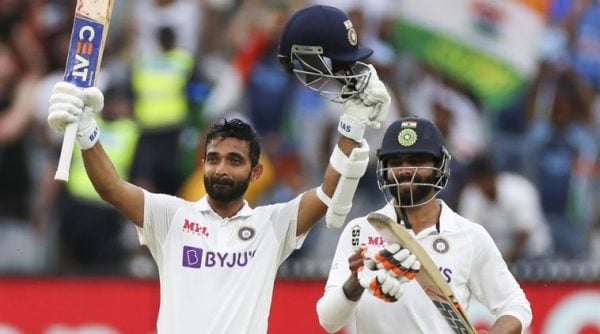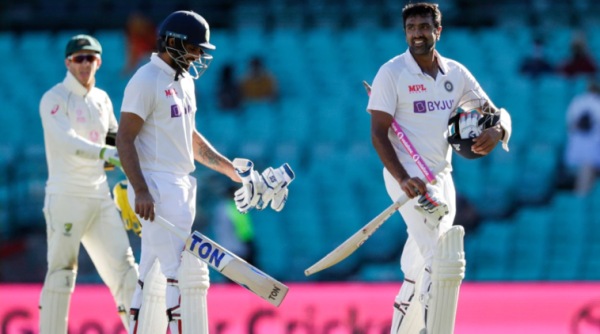Shared News: December 19, 2021 1:11:10 pm
India’s Virat Kohli, left, begins to walk off after he was caught out for 4 runs against Australia on the third day of their cricket Test match at the Adelaide Oval in Adelaide. (AP Photo)
On December 19, 2020, the Indian cricket team suffered the ignominy of being restricted to its lowest ever total in Test cricket, collapsing to 36/9 in the second innings against Australia on the third morning of the first Day/Night Test at Adelaide Oval.
India’s previous lowest score was 42 at Lord’s in 1974 against England, known in Indian cricket parlance as ‘Summer of 42.’
In an inexplicable collapse, India’s much-vaunted batsmen fell like nine pins, with no one able to reach double figures. At one stage, India were reduced to 26/8 and looked like equalling the lowest ever Test score (26 by New Zealand), but Hanuma Vihari’s boundary helped them evade entry into the dark pages of cricketing history.
However, the beauty of the sport is that it forgets and forgives. It offers a chance for redemption. The Indian team did have their ‘baptism by fire’ moment as they went on to win the won the series 2-1, including a three-wicket win at the Gabbatoir, a fortress that has not been breached in 32 years.
Captain Ajinkya stands tall at MCG
Not to forget, India’s Test captain Virat Kohli left the tour after the first Test as he was granted paternity leave to return home. India was also missing the service of star pacer Mohammed Shami, who sustained a wrist injury from a short ball from Pat Cummins in the first Test.

Ajinkya Rahane celebrates after scoring a century as Ravindra Jadeja watches during second Test against Australia. (AP)
The stand-in captain Ajikya Rahane marshalled his troops admirably on the field. He struck a priceless century in adversity to put India in a commanding position in the second Test at the Melbourne Cricket Ground. India won the Test by eight wickets to level the series.
The Sydney heist
Indian pulled off a massive heist in the next Test in Sydney. India earned a draw in the third Test in Sydney on the back of a memorable fourth innings batting performance.

Ravichandran Ashwin and Hanuma Vihari put on a match-saving partnership for India at the SCG. (BCCI)
After the biggest loss in Adelaide and the grandest win in Melbourne, this Test series of extremes threw up the most incredible draw in Sydney. In the end, India’s pride was left scarless despite a broken hand, a bruised elbow, a sore hamstring, and a few dents on the chest as they hung on to finish the final day at 334 for five, leaving the four-game series at 1-1. This was the longest fourth innings by India in 41 years, after the draw against England in 1979. On Monday, they batted 131 overs with four batsmen — Cheteshwar Pujara (77), Rishabh Pant (97), Hanuma Vihari (23 not out), and Ravi Ashwin (39 not out) — playing over 100 deliveries each. To start with, India came to the third Test with one experienced fast bowler – Jasprit Bumrah – at their disposal. Ishant Sharma missed the series. Mohammed Shami’s arm fracture in the first Test in Adelaide ended his Australian sojourn. Umesh Yadav suffered a calf muscle injury during the second Test in Melbourne and returned home. India had Mohammed Siraj – playing only his second Test – and debutant Navdeep Saini alongside Bumrah. Then, the visitors lost Ravindra Jadeja to a finger fracture. Although Jadeja was padded up during India’s second innings, Ashwin came ahead of him and remained unbeaten till the end. Vihari pulled his hamstring very early into his innings on the final day. He could barely move between the wickets but remained unbeaten, facing 161 deliveries.
The Gabatoire breach
‘See you at Gabba mate,’ the exact words of the then Australian skipper Tim Paine when he was sledging India’s R Ashwin, who was batting despite having a severe back spasm. https://youtu.be/wY6UyatwVTA However, Tim Paine’s ‘see you at Gabba’ remark comes back to haunt him at the Gabba. Indian cricket team saddled with broken bones and battered bodies showed a never-seen-before zeal to retain the coveted Border-Gavaskar Trophy with a historic three-wicket win over Australia in the fourth and final Test. The highlights package of Pant’s battle with Nathan Lyon can be enjoyed repeatedly in times to come as he demolished the 100-Test man in the company of debutant Washington Sundar (22), who hooked the world’s best fast bowler, Pat Cummins, for a six. No one moved from their seats as Pant cut, drove, and paddle-swept to make a statement to his detractors while gifting India one of their finest overseas wins during the dying moments of the final session with an off-driven boundary. While Shubman Gill (91 off 146 balls) announced his arrival on the global stage, Cheteshwar Pujara (56 off 211 balls) surpassed all the pain barriers en route to his slowest Test fifty that held the game in balance for Pant to launch a final assault. In terms of relevance, a series win without Virat Kohli, Mohammed Shami, Ravindra Jadeja, Ravichandran Ashwin, and Jasprit Bumrah not being available at various points. The series will be remembered for ages and Ajinkya Rahane’s team’s impact on the cricketing fraternity and the fans.




